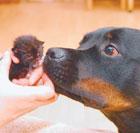Inmates at Women's Prisons in California Save Lives by Fostering Feral Kittens

In a nation known more for the atrocities that it commits against foreigners and its own underclasses, legalized feline genocide does not attract much attention. Nonetheless, it is an undeniable fact of life in twenty-first century America that almost one-hundred per cent of all feral cats apprehended by the authorities are immediately exterminated. There is not any waiting period, no due process hearing, and appeals are not allowed. The enormity of the barbarism involved in these mass exterminations and the petit fait that these cats have not committed any crime other than having the temerity to be born does not seem to trouble very many people.
At long last there is a small ray of hope for feral kittens and it comes from the most unlikely of sources: female inmates. In a novel approach aimed at reducing both feline exterminations and inmate recidivism, the Solano County Sheriff's Claybank Sentenced Detention Center in Fairfax, sixty-two kilometers west of San Francisco, and the Blaine Street jail in Santa Cruz, ninety-five kilometers south of the famous cable cars, have inaugurated programs whereby female inmates serve as surrogate mothers to feral kittens.
Although feral kittens are considerably easier to socialize than adult feral cats, someone still has to do the nurturing until they are old enough to be desexed -- a precondition for adoption at just about all shelters nowadays -- and this is where the female inmates come in. The kittens are transported from shelters to the prisons and live with the inmates in their cells. Usually there are two kittens and two inmates per cell. The caregivers feed, bathe, clean up after, doctor, and play with their charges. The kittens are provided with plenty of food, attention, and toys. They are, however, generally required to sleep in their cages.
When the kittens grow to be two pounds in weight, usually in about six to eight weeks, they are taken from their surrogate mothers, sterilized, and put up for adoption. Although this may seem cruel, the inmates and their families on the outside are given first choice at adopting them. If they decline to do so, the extensive journals that they are required to keep detailing each kitten's nurturing are then turned over to their new caregivers along with the kittens' "baby" pictures.
Inmates selected as surrogate mothers must first be enrolled in a substance abuse program and then complete a lengthy application process which includes both written and oral examinations. Caring for the kittens not only gives them something worthwhile to do with their time, but it also helps to brighten up their otherwise dreary gray cells. They also learn parenting skills, earn certificates of achievement, and receive reductions in their sentences. Most importantly, they save innocent lives.
"It gives me a chance to bond," Latisha Bevilacqua (pictured above on the right with her kitten, Lilyanna) of the Fairfax facility recently told The California Aggie of UC-Davis. "It's inspirational for me to know that if it was not for us girls, they wouldn't have a chance." Once she is released in January she plans to volunteer at an animal shelter.
Bevilacqua's cellmate, Donica Laury (pictured above on the left with Lucky Charm) is also appreciative of the opportunity to care for her kitten even as she prepares to say goodbye to him in a few weeks. "It's going to be emotional, but you know that they're going to be adopted out," she said. "We know we are supposed to say goodbye."
At the Santa Cruz lockup, Stephanie Kolanda (pictured below with Dasha) told the Santa Cruz Sentinel that whenever she is feeling stressed she plays with the kittens. "You know, I'll pull the cat toys or wave the peacock feather or string. They like to try to eat the yarn when you crochet," she said. "There's just a thing with cats, they make you laugh." She has asked her mother to adopt Dasha for her.

Some libraries adopt domesticated cats as mascots and many farmers accept feral cats to live in their barns. Thousands of domestic cats and feral kittens could be saved if schools, institutions, and businesses could be talked into adopting them. Proprietors of old folks' homes could also help out by relaxing their bans on pet ownership.
Contrary to popular belief, adult feral cats can also be domesticated but this requires more time, patience, and effort than most people are willing to invest. It is therefore paramount that sanctuaries be established for them. By arguing that they cannot be tamed, shelters and certain phony-baloney animal rights groups have created a handy justification for exterminating them.
All cat-lovers owe the inmates in both Fairfield and Santa Cruz a hearty thank you for saving the lives of so many feral kittens. This is a worthy program that should be expanded to other prisons around the country.
Photos: Vanessa Stumpf, The California Aggie and Bill Lovejoy, the Santa Cruz Sentinel.







